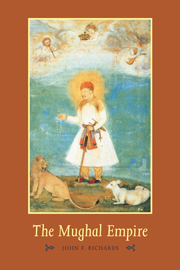Book contents
- Frontmatter
- Contents
- List of maps and tables
- General editor's preface
- Preface
- Introduction
- 1 Conquest and stability
- 2 The new empire
- 3 Autocratic centralism
- 4 Land revenue and rural society
- 5 Jahangir 1605–1627
- 6 Shah Jahan 1628–1658
- 7 The War of Succession
- 8 Imperial expansion under Aurangzeb 1658–1689
- 9 The economy, societal change, and international trade
- 10 Maratha insurgency and Mughal conquest in the Deccan
- 11 The Deccan Wars
- 12 Imperial decline and collapse, 1707–1720
- Conclusion
- Glossary
- Bibliographic essay
- Index
- THE NEW CAMBRIDGE HISTORY OF INDIA
12 - Imperial decline and collapse, 1707–1720
Published online by Cambridge University Press: 28 March 2012
- Frontmatter
- Contents
- List of maps and tables
- General editor's preface
- Preface
- Introduction
- 1 Conquest and stability
- 2 The new empire
- 3 Autocratic centralism
- 4 Land revenue and rural society
- 5 Jahangir 1605–1627
- 6 Shah Jahan 1628–1658
- 7 The War of Succession
- 8 Imperial expansion under Aurangzeb 1658–1689
- 9 The economy, societal change, and international trade
- 10 Maratha insurgency and Mughal conquest in the Deccan
- 11 The Deccan Wars
- 12 Imperial decline and collapse, 1707–1720
- Conclusion
- Glossary
- Bibliographic essay
- Index
- THE NEW CAMBRIDGE HISTORY OF INDIA
Summary
Aurangzeb died March 3, 1707, in his encampment at Ahmadnagar in the Deccan. In a written will the emperor made a futile attempt to divide the empire between his three living sons. Instead, the usual war of succession, so long delayed, broke out almost immediately. At the imperial encampment, Prince Azam Shah, supported by the imperial wazir, Asad Khan, adopted royal titles, struck coins and marched north toward Agra. At the frontier fortress of Jamrud, in the Hindu Kush, his elder brother Muazzam received the news of his father's death twenty days later. Imperial messengers had averaged seventy miles per day to bring the dispatches over 1,400 miles. Muazzam, who had been preparing his army for the inevitable war for well over a year, began a forced march south to Agra.
At a site just north of Lahore, Muazzam declared his accession to the throne and took the title of Bahadur Shah. By June 1st the newly crowned emperor occupied Delhi. By June 12 he arrived at Agra where he met his son Prince Muhammad Azim, who had marched from Bengal and took possession of Agra fort and the central treasury. The imperial reserves at Agra proved to be little depleted by the Deccan wars. Bahadur Shah's officers found coined and uncoined gold and silver totalling 240 million rupees – considerably greater than Akbar's reserves at his death. Muhammad Azim brought additional funds from the Bengal treasury which further strengthened his father's cause.
Keywords
- Type
- Chapter
- Information
- The Mughal Empire , pp. 253 - 281Publisher: Cambridge University PressPrint publication year: 1993



